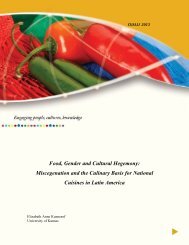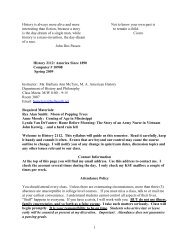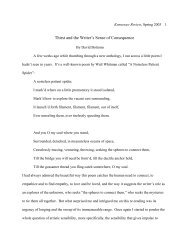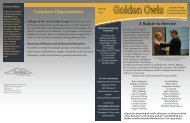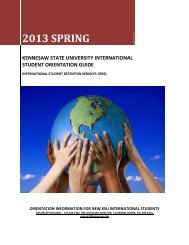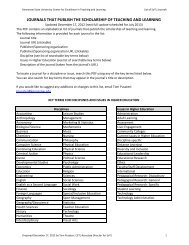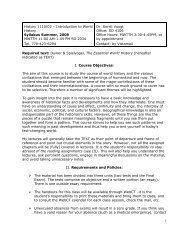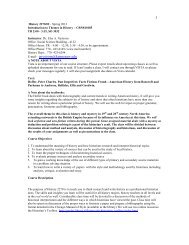Beyond Rosie: Women in World War II - Kennesaw State University
Beyond Rosie: Women in World War II - Kennesaw State University
Beyond Rosie: Women in World War II - Kennesaw State University
You also want an ePaper? Increase the reach of your titles
YUMPU automatically turns print PDFs into web optimized ePapers that Google loves.
<strong>Beyond</strong> <strong>Rosie</strong>: <strong>Women</strong> <strong>in</strong> <strong>World</strong> <strong>War</strong> <strong>II</strong><br />
stated, “We are very glad <strong>in</strong>deed to announce to members of Labor unions that Nellie’s<br />
Cafe is now under new management and has signed an agreement with the Waitresses<br />
and Cooks Union Locals.” Laundry workers <strong>in</strong> Baytown, Texas, telephone operators<br />
<strong>in</strong> Fort Worth, and mill workers <strong>in</strong> Houston made similar announcements followed by<br />
contracts which provided for better wages, vacations, holidays, and work<strong>in</strong>g conditions.<br />
Although unusual, some contracts <strong>in</strong>cluded such benefits as protection of jobs dur<strong>in</strong>g<br />
maternity leave for up to one year.<br />
Regardless of the criticism, women managed to w<strong>in</strong> <strong>in</strong> a wide range of office elections.<br />
On the national level, women directed union committees such as the CIO <strong>War</strong> Relief<br />
Committee’s Latane Lambert. She expla<strong>in</strong>ed that many women could not explore<br />
leadership possibilities because they worked eight hours, kept house, and took care of<br />
children. They had little time for leadership.<br />
Many women, though, did f<strong>in</strong>d time to lead. Most of them represented women who<br />
began union activities <strong>in</strong> the years before <strong>World</strong> <strong>War</strong> <strong>II</strong>. They had taken the normal,<br />
although slow, route through the labor bureaucracy. Mrs. Hershel Davis became<br />
president of the UAW, Paul<strong>in</strong>e Newman directed the educational programs for the<br />
ILGWU, and Jennie Matyas served as the AFL representative to the Advisory Commission<br />
of the <strong>War</strong> Manpower Commission.<br />
PAGE 34<br />
On the state and local level women also <strong>in</strong>creased their <strong>in</strong>fluence. In Texas, both Emily<br />
Jordan and Ethel Still served as vice-presidents of the <strong>State</strong> Federation of the AFL.<br />
In 1946, the Texas <strong>State</strong> CIO nom<strong>in</strong>ated a woman as president. Alda Mae Cornaud<br />
decl<strong>in</strong>ed stat<strong>in</strong>g, “I feel like that is a man’s job” and accepted a vice-president’s post.<br />
Other women served as local presidents and delegates to district, state, and <strong>in</strong>ternational<br />
conventions.<br />
Union women also proved themselves capable of form<strong>in</strong>g a national coalition to support<br />
their causes. Unions, auxiliaries, Eleanor Roosevelt, and work<strong>in</strong>g-class leaders<br />
jo<strong>in</strong>ed forces to campaign aga<strong>in</strong>st the passage of the Equal Right Amendment (ERA).<br />
Mary Anderson, the Directors of the <strong>Women</strong>’s Bureau <strong>in</strong> Wash<strong>in</strong>gton, D.C., provided<br />
the leadership <strong>in</strong> this crusade. By oppos<strong>in</strong>g the ERA, Anderson and her followers<br />
followed the recommendations of a 1942 AFL report which stated the ERA would<br />
“deny homemakers and <strong>in</strong>dustrial women the benefit of the laws which seek to assure<br />
the child the support of his father” and would threaten exist<strong>in</strong>g protective legislation<br />
for women. The CIO agreed, and <strong>in</strong> 1933, its president, Philip Murray, described the<br />
ERA as dangerous. He stated the amendment would be used as “a wedge aga<strong>in</strong>st all<br />
social laws protect<strong>in</strong>g workers.” (26)<br />
Anderson saw few rewards for work<strong>in</strong>g-class women <strong>in</strong> the ERA. She believed the<br />
fem<strong>in</strong>ist call for “equal opportunity” would be unsuitable for work<strong>in</strong>g-class women.<br />
She had come from the garment and shoe <strong>in</strong>dustries and related best to work<strong>in</strong>g-class<br />
women and their issues. She proposed an alternative to the ERA which she felt represented<br />
their views. The Anti-ERA Charter recognized <strong>in</strong>equality. The Charter de-



